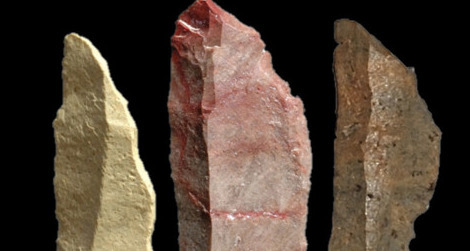Whatever Happened to Kenyanthropus platyops?
Scientists disagree over whether a 3.5-million-year-old skull is a flat-faced species of hominid or just a distorted example of Australopithecus afarensis
![]()
Three and a half million years ago was the heyday of Australopithecus afarensis. But Lucy’s species may not have been alone. In 1999, researchers working in West Turkana, Kenya, uncovered a roughly 3.5-million-year-old hominid skull with a face too flat to belong to A. afarensis. The skull’s finders decided it must be a new species, Kenyanthropus platyops.
At the time, anthropologists disagreed over K. platyops‘ identity and place in the human family tree. While some researchers take the species as a sign that there was a diversity of hominid types around during the middle Pliocene epoch, others say the K. platyops skull is not actually a distinct species at all—it’s simply a distorted skull of an A. afarensis.
Where does the debate stand today?
In 2010, some of the original describers of K. platyops—Fred Spoor of the Max Planck Institute for Evolutionary Anthropology in Germany and Meave Leakey of the Koobi Fora Research Project—worked with Koobi Fora’s Louise Leakey to reanalyze the skull. In their new analysis, the team used CT scans of the skull to assess how distorted the fossil really is. Although the skull contains numerous cracks, the shape of the skull and teeth remain largely unaffected by the damage, the researchers reported in Proceedings of the Royal Society B.
With that in mind, Spoor and the two Leakeys compared the physical features of K. platyops to those of A. afarensis and six other extinct hominid species, in addition to modern humans, chimpanzees and gorillas. According to the researchers, the results confirmed that K. platyops was significantly different from other hominid species, mainly in its flat face, forward-facing cheekbones and small molars (over time, the molars got bigger and bigger in the many species of Australopithecus before getting small again in the genus Homo). Thus, the fossil deserves to be in its own species, they concluded.
Of course, one paper never really settles a debate in human evolution. The Smithsonian Human Origins Program, for example, doesn’t include K. platyops in its list of hominid species and categorizes the K. platyops skull as A. afarensis. Many scientists probably won’t be convinced unless more fossils matching K. platyops are found. There are some other fragments of teeth and skull from West Turkana that may belong to the species, but those fossils don’t really shed any further light on the issue.
For those who do accept K. platyops as a distinct hominid, there’s not much to say about the species. Given its age, it’s possible that K. platyops made the famous footprints preserved at Laetoli in Tanzania. The footprints reveal that some sort of hominid with a modern gait was alive at the time. The more popular theory, however, is that A. afarensis was the upright walker at Laetoli.
Regardless of K. platyops‘ status as a species, it’s not the only evidence that more than one type of hominid lived in East Africa alongside Lucy. In April, researchers unearthed a 3.4-million-year-old hominid foot in Ethiopia that retained too many features related to climbing to be the foot of A. afarensis. Who knows—maybe it belonged to K. platyops.
/https://tf-cmsv2-smithsonianmag-media.s3.amazonaws.com/accounts/headshot/science-erin-wyman-240.jpg)

/https://tf-cmsv2-smithsonianmag-media.s3.amazonaws.com/accounts/headshot/science-erin-wyman-240.jpg)